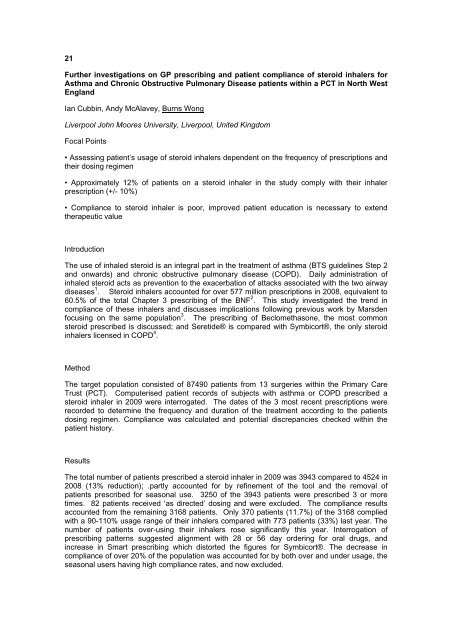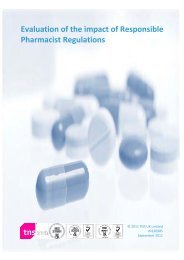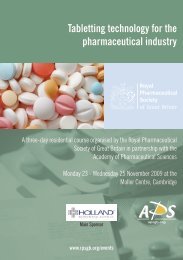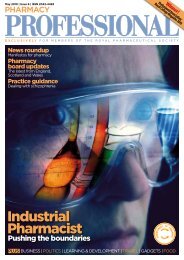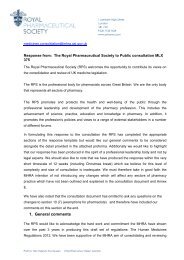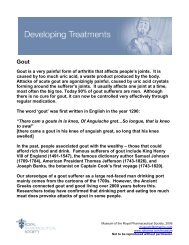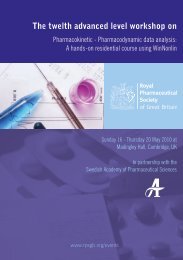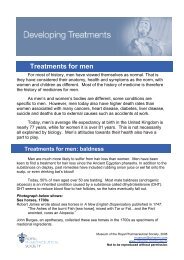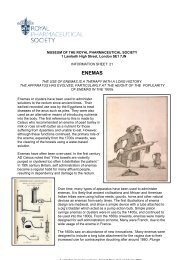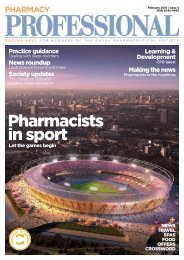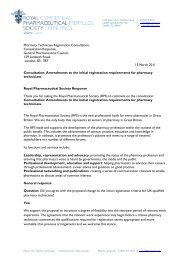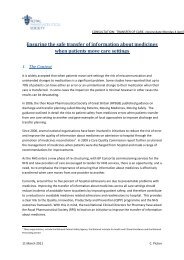RPS Conference 2010, Abstracts 2010 - Royal Pharmaceutical Society
RPS Conference 2010, Abstracts 2010 - Royal Pharmaceutical Society
RPS Conference 2010, Abstracts 2010 - Royal Pharmaceutical Society
Create successful ePaper yourself
Turn your PDF publications into a flip-book with our unique Google optimized e-Paper software.
21<br />
Further investigations on GP prescribing and patient compliance of steroid inhalers for<br />
Asthma and Chronic Obstructive Pulmonary Disease patients within a PCT in North West<br />
England<br />
Ian Cubbin, Andy McAlavey, Burns Wong<br />
Liverpool John Moores University, Liverpool, United Kingdom<br />
Focal Points<br />
• Assessing patient’s usage of steroid inhalers dependent on the frequency of prescriptions and<br />
their dosing regimen<br />
• Approximately 12% of patients on a steroid inhaler in the study comply with their inhaler<br />
prescription (+/- 10%)<br />
• Compliance to steroid inhaler is poor, improved patient education is necessary to extend<br />
therapeutic value<br />
Introduction<br />
The use of inhaled steroid is an integral part in the treatment of asthma (BTS guidelines Step 2<br />
and onwards) and chronic obstructive pulmonary disease (COPD). Daily administration of<br />
inhaled steroid acts as prevention to the exacerbation of attacks associated with the two airway<br />
diseases 1 . Steroid inhalers accounted for over 577 million prescriptions in 2008, equivalent to<br />
60.5% of the total Chapter 3 prescribing of the BNF 2 . This study investigated the trend in<br />
compliance of these inhalers and discusses implications following previous work by Marsden<br />
focusing on the same population 3 . The prescribing of Beclomethasone, the most common<br />
steroid prescribed is discussed; and Seretide® is compared with Symbicort®, the only steroid<br />
inhalers licensed in COPD 4 .<br />
Method<br />
The target population consisted of 87490 patients from 13 surgeries within the Primary Care<br />
Trust (PCT). Computerised patient records of subjects with asthma or COPD prescribed a<br />
steroid inhaler in 2009 were interrogated. The dates of the 3 most recent prescriptions were<br />
recorded to determine the frequency and duration of the treatment according to the patients<br />
dosing regimen. Compliance was calculated and potential discrepancies checked within the<br />
patient history.<br />
Results<br />
The total number of patients prescribed a steroid inhaler in 2009 was 3943 compared to 4524 in<br />
2008 (13% reduction); .partly accounted for by refinement of the tool and the removal of<br />
patients prescribed for seasonal use. 3250 of the 3943 patients were prescribed 3 or more<br />
times. 82 patients received ‘as directed’ dosing and were excluded. The compliance results<br />
accounted from the remaining 3168 patients. Only 370 patients (11.7%) of the 3168 complied<br />
with a 90-110% usage range of their inhalers compared with 773 patients (33%) last year. The<br />
number of patients over-using their inhalers rose significantly this year. Interrogation of<br />
prescribing patterns suggested alignment with 28 or 56 day ordering for oral drugs, and<br />
increase in Smart prescribing which distorted the figures for Symbicort®. The decrease in<br />
compliance of over 20% of the population was accounted for by both over and under usage, the<br />
seasonal users having high compliance rates, and now excluded.


